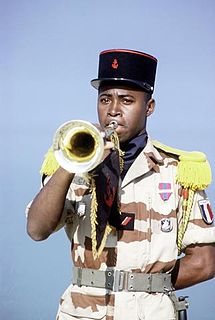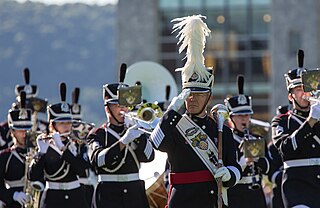
A military band is a group of personnel that performs musical duties for military functions, usually for the armed forces. A typical military band consists mostly of wind and percussion instruments. The conductor of a band commonly bears the title of Bandmaster or Director of Music. Ottoman military bands are thought to be the oldest variety of military marching bands in the world, dating from the 13th century.

A fife is a small, high-pitched, transverse aerophone of Portuguese origin, that is similar to the piccolo. The fife originated in medieval Europe and is often used in Fife and Drum Corps, military units, and marching bands. Someone who plays the fife is called a fifer. The word fife comes from the German Pfeife, meaning pipe, which comes from the Latin word pipare.

Beating Retreat is a military ceremony dating to 17th-century England and was first used to recall nearby patrolling units to their castle.

A bugle call is a short tune, originating as a military signal announcing scheduled and certain non-scheduled events on a military installation, battlefield, or ship. Historically, bugles, drums, and other loud musical instruments were used for clear communication in the noise and confusion of a battlefield. Naval bugle calls were also used to command the crew of many warships.

United States military bands include musical ensembles maintained by the United States Army, United States Marine Corps, United States Navy, United States Air Force, and United States Coast Guard. More broadly, they can also include musical ensembles of other federal and state uniformed services, including the Public Health Service and NOAA Corps, the state defense forces, and the senior military colleges.

The Royal Marines Band Service is the musical wing of the Royal Navy and an independent element of the Royal Marines. It currently consists of five bands plus a training wing – the Royal Marines School of Music at HMS Nelson – and its headquarters is at HMS Excellent, Whale Island, Portsmouth.

Martial music or military music is a specific genre of music intended for use in military settings performed by professional soldiers called field musicians. Much of the military music has been composed to announce military events as with bugle calls and fanfares, or accompany marching formations with drum cadences, or mark special occasions as by military bands. However, music has been employed in battle for centuries, sometimes to intimidate the enemy and other times to encourage combatants, or to assist in organization and timing of actions in warfare. Depending on the culture, a variety of percussion and musical instruments have been used, such as drums, fifes, bugles, trumpets or other horns, bagpipes, triangles, cymbals, as well as larger military bands or full orchestras. Although some martial music has been composed in written form, other music has been developed or taught by ear, such as bugle calls or drum cadences, relying on group memory to coordinate the sounds.

A Corps of Drums, also sometimes known as a Fife and Drum Corps, Fifes and Drums or simply Drums is a unit of several national armies. Drummers were originally established in European armies to act as signallers. The major historical distinction between a military band and a corps of drums, was that 'drummers' were not employed to play their instruments to entertain or delight, but rather they carried out a utilitarian battlefield role. This role was fulfilled by trumpeters or buglers in the cavalry and the artillery, who did not form into comparative formed bodies in the way that drummers did; therefore, an orthodox corps of drums will exist in the infantry arm.

A fanfare band, fanfare corps, fanfare battery, fanfare team, horn and drum corps, bugle band, drum and bugle corps, or trumpet and drum band is a military or civilian musical ensemble composed of percussion instruments, bugles, natural horns and natural trumpets. Fanfare bands are the descendants of the old medieval trumpet and drum teams that sounded fanfares on important occasions and are related to drum and bugle corps internationally.

A drummer was responsible for the army drums for use on the battlefield. Drums were part of the field music for hundreds of years, being introduced by the Ottomans to Europe. Chinese armies however had used drums even before that. With the professionalization of armies, military music was developed as well. Drums were not only used for the men to march in step, but were an important part of the battlefield communications system, with various drum rudiments used to signal different commands from officers to troops. By the second half of the 18th century, most Western armies had a standardized set of marches and signals to be played, often accompanied by fifers.

A drum major in the military refers to someone who is the individual leading a military band or a field unit. It is an appointment, not a military rank. Military drum majors utilize a ceremonial mace for giving commands while marching. Many drum majors, particularly American- or British-influenced ones, wear a sash that can carry embroidered badges of their home unit and battle honors; a pair of ceremonial drum sticks are often attached.

The Royal Artillery Mounted Band was a British military band consisting of woodwind, brass, and percussion instruments, and military unit, founded in 1886, and in existence until 1984, representing the Royal Artillery, and the Royal Horse Artillery, and augmenting the Royal Artillery Band at royal and state occasions.

Canadian military bands are a group of personnel in the Canadian Armed Forces (CAF) that performs musical duties for military functions. Military bands form a part of the Music Branch of the CAF, composed of six full-time professional Regular Force bands, 15 Regular Force voluntary bands, and 53 part-time reserve force bands. Bands of the Music Branch are often badged with the unit or Canadian Forces base insignia that they support.

The Royal Artillery Band was the first official, and permanent British military band originating in 1557, but granted official status in 1762. Consisting of woodwind, brass, and percussion instruments, it represented both the Royal Regiment of Artillery, and the state. The Royal Artillery Orchestra [disbanded on 9 February 2014] was Britain's first permanent professional orchestra. All other bands in the British Army received official, permanent status from 1763 onward. Now that the band's overall history of over four and a half centuries has come to an end, it is now claimed that the Band of the Grenadier Guards are the oldest band, with their overall history of over three hundred and thirty years. It is however, important to consider that until 1762, all military bands were formed as and when required, and then immediately disbanded when not, and that they consisted only of hired, civilian musicians; becoming integrated professional soldiers in 1762 and from 1763. The Royal Artillery in Bern, Switzerland, in 1980: []

Military and processional music was designed to fulfil necessary functions in a military environment, and accompanies pageants, parades, ceremonies, processions.

The West Point Band is the U.S. Army's oldest active band and the oldest unit at the United States Military Academy, traces its roots to the American Revolutionary War. At that time, fifers and drummers were stationed with companies of minutemen on Constitution Island, across the river from West Point. In 1778, General Samuel Holden Parsons' 1st Connecticut Brigade crossed the Hudson River and established West Point as a permanent military post. After the American Revolution, Congress disbanded most of the Continental Army, but "the 55 men at West Point", members of the 2nd Continental Artillery, remained as they were. Among their ranks stood at least one drummer and one fifer, who alone maintained the tradition of military music at West Point.

United States military music customs are the traditional, regulatory, and statutory provisions that guide performances by United States military bands during drill and ceremony and state occasions.

The Music of the Foreign Legion, formerly known as the Principal Music of the Foreign Legion is a Military band of the French Foreign Legion.

Military bands in the United Kingdom are the musical units that serve for protocol and ceremonial duties as part of the British Armed Forces. They have been the basis and inspiration for many military bands in the former British Empire and the larger Commonwealth of Nations as well as musical organizations in other countries. Military musical units with British influence include United States military bands, the Japan Ground Self-Defense Force Music Corps and the Military Band of Athens. British military bands are controlled by the military music departments of the three services that compose the armed forces. These include the Royal Marines Band Service, the Royal Corps of Army Music, and the Royal Air Force Music Services. British style brass bands and carnival bands were then and are currently inspired by the British Armed Forces and its brass bands, especially of the Army's regular and reserve formations, as they follow a similar format as it relates to brass and percussion instruments.
A regiment is a military unit that has been in use by the United States Army since its inception. Derived from the concept originating in European armies, a regiment was historically commanded by a Colonel and consisted ten companies for approximately 1,000 soldiers, although the exact composition varied depending on time period and other factors. The regiment was both an administrative and tactical unit in the US Army.




















